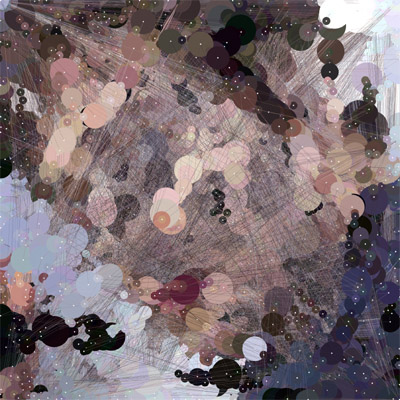I think I did not look this project as it deserves: Generating Art from a Computer Game. It's actually an interview with Alison Mealey by Artifical.dk (a great news resource for information about net art, software art, and other computer based art forms as it defines it).
Alison Mealey has chosen to base her art on the computer game Unreal Tournament. More precisely, she lets a number of virtual players play the game for approximately 30 minutes at a time and uses the data from the games to produce complex drawings. These drawings are also based on photographic portraits.
For instance, Alison Mealey: Unrealart, Jake, 2005.

Why do I blog this? Since I am interested in location-awareness and how people use others' position in space, it's this aspect that interested me in this project:
Interviewer:I'd like to learn a bit more about the relations between the data from the game and the visual output. How are the characteristics of the lines and circles determined from the game data? Alison; Only two types of data are taken from the game. The position of every player (taken every second), and the acknowledgement of a death. As the data from the game is coming in 1 second chunks, Processing takes every seconds chunk and produces a drawing from it, these drawings are built up over time to produce the final images. The circles represent the positions of the players. The X and Y positions taken from the players are drawn as-is, producing a top down 2D view of 'the field of play'/canvas. The Y values from the players alter the size of the circles, if a bot is mid jump they are therefore closer to the camera and the circles will be bigger, if they are crouching the circles will be smaller. The Y values have been greatly exaggerated in some of the more recent works, to produce (in my opinion) more beautiful images. The lines simply connect every second's points to produce separate drawings from every second. The death data is used in some of the images as a big black circle, indicating where a death took place. In some of the other works the death data forces a global colour change.
Of course, it's quite messy but it's an amazing way of visualizing players' paths, it's definitely less precise than what the Whereabouts clock can show BUT it's less intrusive and anonymous...